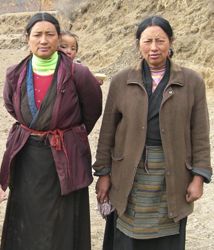Zhaba Profile
Autonym: ɳɖa pi
Other names: 扎坝,扎巴
Adjacent to the Queyu homeland, the Xianshui River valley heading north from the confluence with the Yalong River is the realm of the 9,000 Zhaba Tibetans. One section of the Xianshui valley is a narrow canyon about 150 km in length, offering spectacular views of towering precipices and the turbulent river below.
Zhaba Tibetans mostly follow the Tibetan Buddhism, and speak a Qiangic language that has northern and southern variations. They live in impressive 4 or 5 story pillbox-like houses made from local stone, rising to 20 meters high. These are decorated with totems and cow skulls for good luck, and wall patterns made from white stones or paint. Wooden ladders connect segments of the home. Logging was once the main industry and means of income of the Zhaba, but in keeping with much of the upper Yangtze region excessive deforestation has led to the widespread ban on logging. Most of the Zhaba have subsequently reverted to farming of corn, apples and herbs for medicine, as well as raising cows, pigs and horses.
A distinctive feature of the Zhaba is their matriarchal society, and the "walking marriage" custom, which may still be practiced in some of the more remote villages to this day. Traditionally, Zhaba women opened their doors to their lovers every evening, and the men walked home to their mother's household every morning. Children grew up in the home of their mother, and male influences in childhood came from maternal male relatives, rather than the children's father. In Zhaba society today, the women still not only do all the housework but also take care of the family farm, while the men are comparatively idle.


